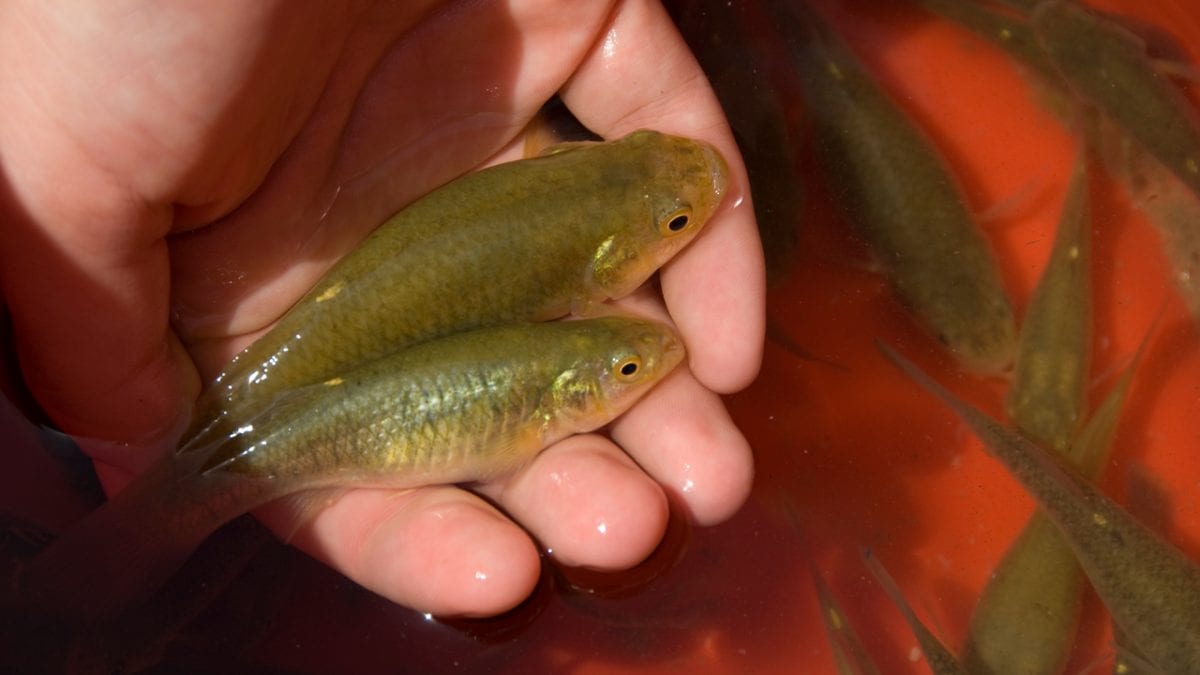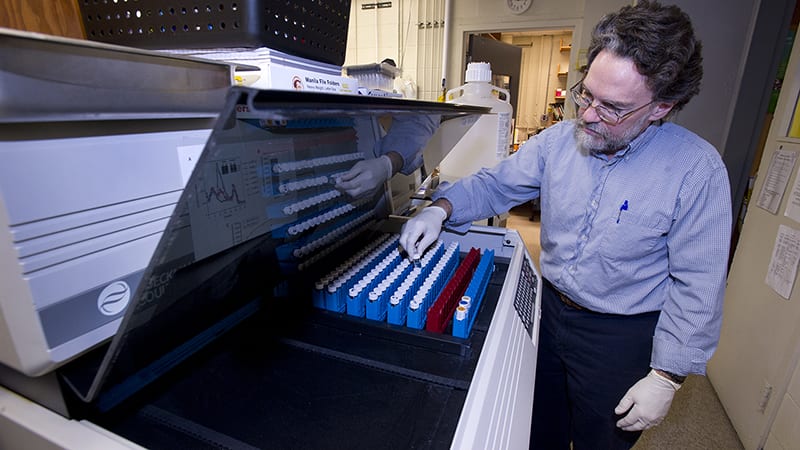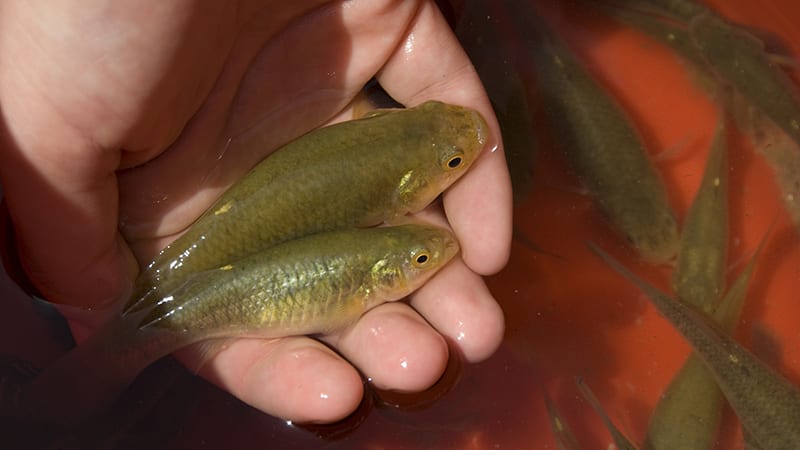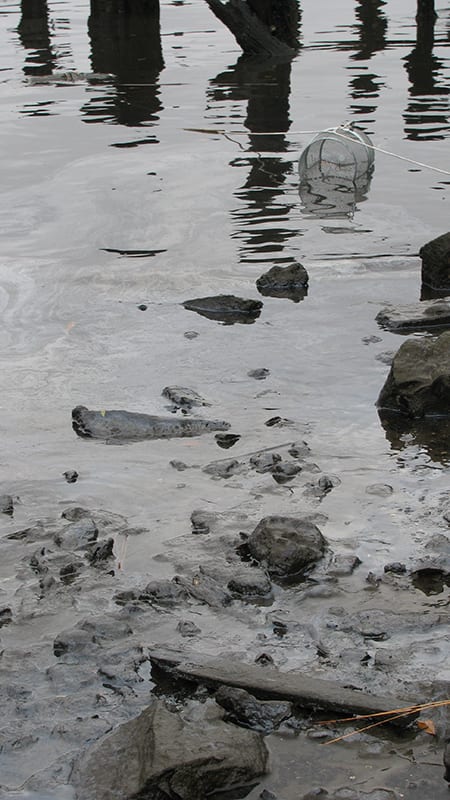Some Fish Quickly Adapt to Lethal Levels of Pollution

December 8, 2016
Evolution is working under pressure to rescue some coastal fish from a lethal, human-altered environment. Now, a new study has revealed the complex genetic basis for the Atlantic killifish’s remarkable resilience.
The new findings, published Dec. 9 in the journal Science, build on decades of research into the killifish’s ability to survive industrial contamination. WHOI collaborated on the new multi-institutional study, which was led by the University of California, Davis.
While environmental change is outpacing the rate of evolution for many other species, killifish living in four polluted East Coast estuaries turn out to be remarkably resilient. These fish have adapted to survive levels of toxic industrial pollutants that would normally kill them, tolerating concentrations up to 8,000 times higher than sensitive fish.
Although killifish are not commercially valuable, they are an important food for other species and an indicator of environmental degradation.
The Anti-Pollution Pathway
WHOI biologists Mark Hahn and Sibel Karchner have been studying PCB-resistant killifish in New Bedford Harbor since 1995 as part of the Superfund Research Program, in collaboration with other WHOI colleagues and with researchers from the U.S. Environmental Protection Agency’s Atlantic Ecology Division in Rhode Island.
“There’s this whole enzyme system that has evolved to protect animals against pollutants,” Hahn said. “But that only works for chemicals that are readily metabolized by those enzymes.”
PCBs and other industrial chemicals are not readily broken down, so the enzyme system and hundreds of associated genes go into overdrive, ultimately harming killifish and killing their embryos.
“The constant stimulation of this genetic response pathway is bad for them—like an overactive immune response in people,” Hahn said.
In the PCB-resistant killifish, however, the response pathway stays turned off, counterintuitively allowing the fish to survive what would usually be a fatal exposure.
“These are really strong selective pressures,” Hahn said. “We’ve introduced chemicals that are going to kill the embryos. So the population will be wiped out, unless there’s a subset of embryos that can tolerate the high concentrations, and unless the genetic characteristics that help them tolerate those concentrations can be passed on.”
The Genetics of Resistance
To better understand the genetic basis for this adaptation, the research team sequenced the genomes of nearly 400 individual killifish from four non-polluted sites and from four polluted ones: New Bedford Harbor, Massachusetts; Newark Bay, New Jersey; Connecticut’s Bridgeport area; and Virginia’s Elizabeth River. Since the 1950s and 1960s, these sites have been contaminated by industrial chemicals, including polychlorinated biphenyls (PCBs), dioxins, and hydrocarbons (PAHs).
Genetic analysis identified hundreds of “hotspots”: regions of the genome that appeared to have undergone natural selection in the pollution-resistant killifish. Several of the strongest hotspots appeared in all four resistant populations; many of those included genes involved in the previously-identified, potentially hyperactive response pathway.
“So the interesting thing is, it doesn’t seem to be just one gene that appears to be responsible for the resistance,” Hahn said. “It’s a group of genes that are all part of the same pathway.”
Killifish are known to have extremely high levels of genetic variation—higher than that of any other vertebrate measured so far, including humans. The more genetic diversity, the faster evolution can act. That’s one reason why insects and weeds can quickly adapt and evolve to resist pesticides, and why pathogens can evolve quickly to resist drugs created to destroy them.
The new findings suggest that the killifish’s genetic diversity makes them unusually well-positioned to quickly adapt and survive in radically altered habitats.
“We have four independent, geographically-separated populations of fish, each of which has evolved resistance to industrial chemicals,” Hahn said. “And in each of these four populations, selection has targeted the same sets of genes from the same molecular pathway, but in slightly different ways.”
This result suggests that before being exposed to pollution, killifish already carried the genetic variation that allowed them to adapt—and that there may only be a limited number of evolutionary solutions to pollution exposure.
Human Implications?
The study lays the groundwork for future research that could explore which genes confer tolerance of specific chemicals. Such work could help better explain how genetic differences among humans and other species may contribute to differences in sensitivity to environmental contaminants.
“If we know the kinds of genes that can confer sensitivity in another vertebrate animal like us, perhaps we can understand how different humans, with their own mutations in these important genes, might react to these chemicals,” said U.C. Davis evolutionary geneticist Andrew Whitehead, the lead author of the study.
“This study shows that different populations of Atlantic killifish exposed to toxic pollution evolve tolerance to that pollution through changes in one molecular pathway,” said George Gilchrist, program director in the National Science Foundation’s Division of Environmental Biology, which funded the study along with the National Institute of Environmental Health Sciences. “This pathway may play a similar role in many animals exposed to pollutants, with slightly different adaptations in response to different toxicants.”
Along with U.C Davis and WHOI, the study’s coauthoring institutions include the U.S. Department of Agriculture, the U.S. Environmental Protection Agency, Washington University School of Medicine, University of Birmingham, Indiana University, and University of Miami.
The Woods Hole Oceanographic Institution is a private, non-profit organization on Cape Cod, Mass., dedicated to marine research, engineering, and higher education. Established in 1930 on a recommendation from the National Academy of Sciences, its primary mission is to understand the ocean and its interaction with the Earth as a whole, and to communicate a basic understanding of the ocean’s role in the changing global environment. For more information, please visit www.whoi.edu.
***
For interviews with Andrew Whitehead, please contact Kat Kerlin, UC David News and Media Relations, 530-752-7704, kekerlin@ucdavis.edu.



